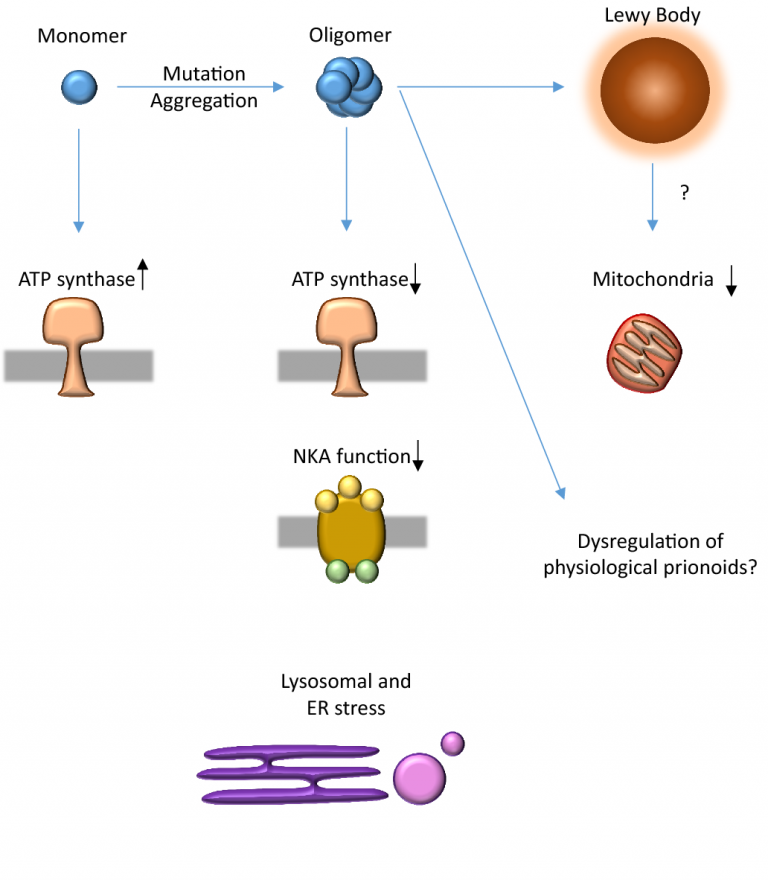MDC publication highlights - April 2019
1 May 2019
April 2019 MDC publication highlights: Untangling the α-synuclein pathology and exploring biological mechanisms of Parkinson’s in non-neuronal cell types.

Biological mechanisms leading to neurodegenerative disorders with α-synuclein pathology
Parkinson’s disease (PD), dementia with Lewy bodies (DLB), and multiple system atrophy (MSA) belong to the group of devastating neurodegenerative disorders resulting in progressive motor and cognitive problems. All these conditions are characterized by cell-death in specific brain regions and by the presence of tangled masses of a protein called α-synuclein (α-syn), hence they are collectively termed α-synucleinopathies. While α-synuclein inclusions are a common hallmark of all these disorders, the pattern and exact nature of the protein deposits, and the resulting pattern of cell dysfunction and death are uniquely specific to each disorder. In this review, the authors describe the multiple factors that contribute to the selective vulnerability of specific cell types and brain regions in α-synucleinopathies and how these interact to form the specific clinical-pathological manifestation of each disorder. The authors propose a mechanism by which the disruption of cellular metabolics, α-syn structural equilibrium, and anatomical connectivity can interact to initiate the pathological processes leading to α-synucleinopathies.
Alegre-Abarrategui et al. ‘Selective vulnerability in α‑synucleinopathies’. Acta Neuropathologica. First published: 20 April 2019, DOI: 10.1007/s00401-019-02010-2.
Clinical, neuropathological and genetic features of Lewy body dementias
Lewy body dementias are the second most common neurodegenerative dementias after Alzheimer’s disease, and include dementia with Lewy bodies (DLB) and Parkinson’s disease dementia (PDD). The main pathological hallmark of both conditions is the presence of Lewy bodies: tangled masses (deposits) in the brain, primarily composed of the α-synuclein (α-syn) protein. Despite this common pathological background, DLB and PDD both show additional distinct patterns of regional brain degeneration and protein dysfunction and deposition, which are closely related to the clinical features of each disorder. This review explores the main clinical, neuropathological and genetic aspects of DLB and PDD, highlighting features and biological mechanisms which may be specifically important for clinical management and therapeutic development for each condition.
Hansen et al. ‘Clinical, neuropathological and genetic features of Lewy body dementias’. Neuropathology and Applied Neurobiology, First published: 12 April 2019, DOI: 10.1111/nan.12554
Moving beyond neurons: role of gene regulation in various cell types in Parkinson’s disease
The most prominent and distinctive pathological characteristics of Parkinson’s disease are the death of dopamine-producing neurons and the presence of masses of tangled proteins (Lewy bodies) in surviving neurons. It is therefore not surprising that the primary focus of Parkinson’s research has always been on neurons, and more specifically, dompamine-producing neurons in the part of the brain that degenerates in Parkinson’s (the substantia nigra). However, in recent years, a growing body of evidence point to the involvement of other cell-types (non-neuronal cells) in Parkinson’s disease. In this study, researchers used genetic expression data from different brain regions and different cell types to explore the relationship between Parkinson’s genetics and various cell types. The researchers found the Parkinson’s genetic risk and pathology seems to be not limited to dopaminergic neurons, but rather related to a more general and global dysfunction affecting various cell types. These findings highlight the need to look beyond the brain and selective neuronal vulnerability in the search of new biological targets which might have therapeutic effects in Parkinson’s disease.
Reynolds et al. ‘Moving beyond neurons: the role of cell type-specific gene regulation in Parkinson’s disease heritability’. NPJ Parkinson’s Disease, First published: 17 April 2019, DOI: 10.1038/s41531-019-0076-6
 Close
Close

